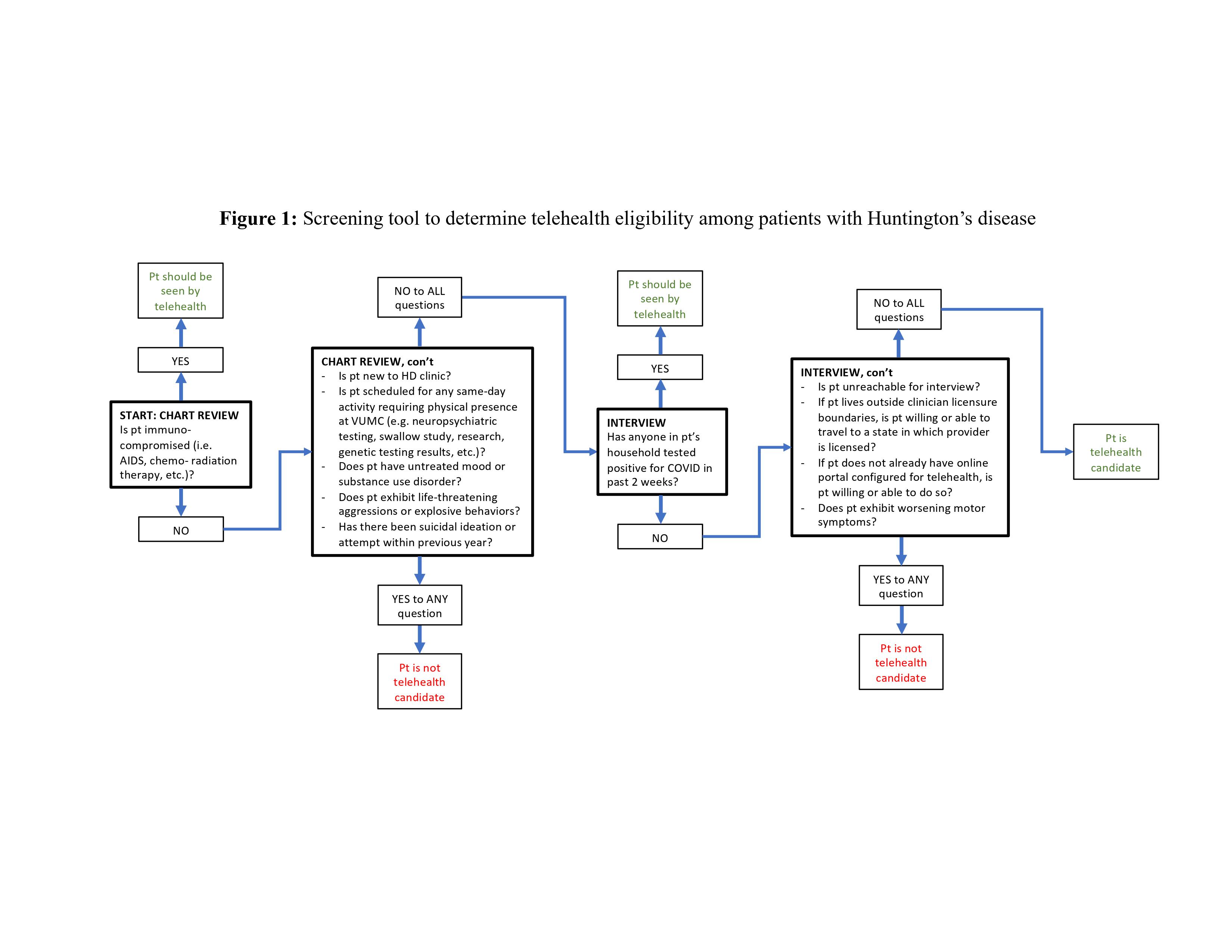Category: Huntington's Disease
Objective: To evaluate a screening tool to assess telehealth (TH) suitability among Huntington’s disease (HD) patients
Background: Extenuating patient circumstances [1] and COVID-19 necessitate greater TH utilization in HD, but how do we identify patients who are suitable for TH? Current assessments of TH eligibility are conducted on a case-by-case basis, instilling variability in clinical practice and reducing TH utilization. Moreover, previous studies [2,3] of TH usage in HD patients indiscriminately assigned patients to TH. To standardize the TH assessment process and to account for underlying factors that influence TH suitability, we designed a screening tool to address the needs of HD patients.
Method: We organized various indications and contraindications to TH into a flowchart [figure1] with two outcomes: eligible or ineligible. In two implementation cycles of four weeks apiece, we ran VUMC HD patients scheduled for clinic visits through the screening tool, aided by chart review and phone interview. Those deemed eligible for TH were given an option of in-person or TH for the upcoming visit. We noted the show-rate among patients who agreed to TH. We also noted the reasons why eligible patients refused TH, and refined our screening tool accordingly between implementation cycles.
Results: In the first cycle, of 42 HD patients, 20 (47.6%) were eligible for TH. Of the 20 TH-eligible patients, 9 (45.0%) agreed to TH, and all showed for their visits. In the second cycle, of 39 HD patients, 18 (46.2%) were eligible for TH. Of the 18 TH-eligible patients, 15 (83.3%) agreed to TH, and 4 were no-shows for a show-rate of 73.3%.
In the four weeks before screening tool implementation, 11 of 55 (20.0%) HD clinic patients were seen via TH. This figure increased to 9 of 42 (21.4%) in the first cycle, and 11 of 39 (28.2%) in the second.
Conclusion: To identify TH candidates among HD patients, we designed a screening tool that increased TH acceptance among eligible patients and overall TH utilization at VUMC HD clinic. Not only will the screening tool promote consistency in the TH assessment process, it will also prepare the HD clinic to quickly transition a large number of in-person visits to TH in the event of worsening COVID-19. Finally, this screening tool can be adapted to serve patients with other movement disorders such as Parkinson’s or ALS.
References: [1] Hawkins AK, Ho A, Hayden MR (2011). Lessons from predictive testing for Huntington disease: 25 years on. Journal of medical genetics, 48(10), 649–650. [2] Hawkins AK, Creighton S, Ho A, McManus B, Hayden MR (2013). Providing predictive testing for Huntington disease via telehealth: results of a pilot study in British Columbia, Canada. Clinical genetics, 84(1), 60–64. [3] Bull MT, Darwin K, Venkataraman V, Wagner J, Beck CA, Dorsey ER, Biglan KM (2014). A pilot study of virtual visits in Huntington disease. Journal of Huntington’s disease, 3(2), 189–195.
To cite this abstract in AMA style:
S. Lee, L. Hale, K. Mcdonell. A screening tool to assess telehealth suitability among patients with Huntington’s disease [abstract]. Mov Disord. 2021; 36 (suppl 1). https://www.mdsabstracts.org/abstract/a-screening-tool-to-assess-telehealth-suitability-among-patients-with-huntingtons-disease/. Accessed December 26, 2025.« Back to MDS Virtual Congress 2021
MDS Abstracts - https://www.mdsabstracts.org/abstract/a-screening-tool-to-assess-telehealth-suitability-among-patients-with-huntingtons-disease/

